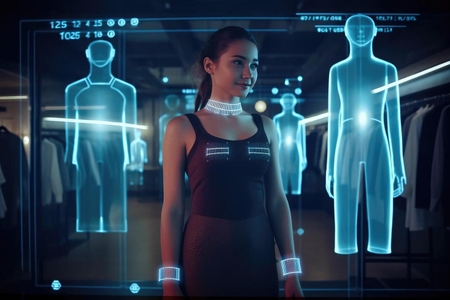
Imagine a world where your clothes are not just a reflection of your style but also your health status. These smart garments are now holding a promising place as a means to connect you to your health and well-being. These wearable biosensor systems can measure and quantify the human body’s physical and chemical signals and provide disease diagnosis, therapy, and health monitoring opportunities. As we are moving towards an era where fashion is meeting technology, let’s see how biosensor-driven smart garments hold the potential to provide us with personalized healthcare solutions.
Smart Garments: Synchronizing Style, Technology and Health
Biosensor-based smart garments, like shirts that can monitor heart rate to leggings that can track posture, are designed to provide a continuous stream of data related to our health conditions.
According to Emergen Research, the global smart garment market is expected to reach USD 2.17 billion in 2027 with a compound annual growth rate (CAGR) of 25.6%.
Let’s discuss the breakthroughs in personalized healthcare that smart garments have brought in.
Real-time Health Monitoring: A Boon to Personalized Healthcare
Smart garments are becoming a matter of interest to health-conscious people due to their non-invasive real-time measurement capabilities. Headbands, collars, tee-shirts, socks, shoes, and leggings equipped with sensors offer continuous monitoring of organ parameters. Bio-signal data can be instantly transmitted to caregivers, enabling early precautionary measures. The Mayo Clinic in the USA has embraced sensor-laden clothing technology, connecting it to a remote patient monitoring platform and reaping potential benefits.
Meeting Patient Needs: Reduction in Cost and Hospital Stays
Smart garments reduce disease risks and enhance early diagnosis, enabling patients to save on doctor visits. They contribute to early patient discharge, keeping individuals at home, and preventing hospital admissions for chronic cardiac or respiratory conditions. Furthermore, E-textiles have applications in treating precancerous skin conditions, neurological disorders like epilepsy and facilitating light drug delivery (e.g., insulin for diabetics). They also aid in pain management for arthritis, resulting in cost reduction and personalized treatments that can be independently used at home.
Empowering Patients Through User-Centric Approach
Smart garments go beyond data collection, revolutionizing personalized healthcare and empowering individuals to manage their well-being actively. These intelligent textiles promote a proactive approach to health. Notably, smart garments seamlessly blend with contemporary style trends. With features like interactive LED patterns and customizable designs, they foster a harmonious union of fashion and functionality. Such user-centric approaches build confidence among users that they are on the right track in their healthcare journey.
Artificial Intelligence Propelling Precision
Smart garments, in addition to continuous health tracking with embedded sensors, are advancing with the integration of Artificial Intelligence (AI). This collaboration aids in processing the substantial data collected by these garments, employing machine learning algorithms to offer precise insights into an individual’s health over time.
A 2022 study highlighted the effectiveness of polymer optical fiber sensors coupled with AI algorithms in decision-making, particularly through analyzing breathing patterns during different daily activities. These advancements hold the promise of revolutionizing preventive healthcare by identifying patterns and predicting potential health issues.
The Spectrum of Smart Garments: Innovations Meeting Precision
The array of smart garments is expanding rapidly, convincingly aiding in personalized healthcare. Let’s look into some examples of these intelligent garments providing all-around health monitoring:
- Smart Shirts that aid in monitoring heart rate, respiratory frequency, and body temperature to detect physical activity and related deviations.
- Smart Bras for Breast Health are equipped with sensors to detect temperature or blood flow changes that may indicate potential issues.
- EKG-Tracking Smart Clothing items with built-in electrocardiogram (EKG) sensors to monitor heart activity.
- Smart Socks monitor temperature and pressure on the feet, aiming to prevent diabetic foot ulcers.
- Glucose-Monitoring Smart Apparel with integrated sensors to monitor glucose levels.
- Sensory baby vests and socks help prevent life-threatening situations and cot deaths in babies.
- Smart Underwear to monitor pelvic floor muscles and provide feedback for pelvic health.
- Life jacket to monitor cuff-less blood pressure through the radial pulse waveform by arterial tonometry.
- Smart Pants to detect tracking and quantifying movements, such as range of motion, for patients undergoing physical rehabilitation.
As technology is evolving every passing day, further innovations in smart garments leading to enhanced personalized healthcare are highly anticipated. But, still, there are several challenges in its implications to a wide range of consumers that need to be addressed.
Bringing in Smart Garments to Patients: Challenges and Issues
Technical Advancements and Privacy Assurance:
As smart garments become integral to daily life, there’s a need to enhance the material durability and the capacity of power sources. Concomitantly, addressing user concerns about the security and privacy of personal health data is of prime importance.
User Acceptance Related Issues:
User acceptance of biosensor-based intelligent textiles is an important aspect to deal with while marketing smart garments. It is of utmost importance that regulatory guidelines are followed strictly to bring in a sense of security and confidence among users to adopt this technology.
Data accuracy hurdles:
The current state of smart clothing is such that the data they collect is often difficult to interpret. This is due to the fact that the data gathered by these devices is highly complex and the algorithms used to interpret it are often not sophisticated enough to accurately measure the user’s collective health. Additionally, the data collected by these devices is often not standardized, making it difficult to compare data sets from different devices.
Summing Up
Smart garments have not only brought technological novelty to the field of healthcare but are acting as a key player in patient-centric approaches. In this dynamic approach to health and wellness, Codewave EIT stands beside you, offering intelligent and sustainable garments (iGarments) that provide robust traceability back to the source. This feature proves especially valuable in recycling waste within a circular economy. Our resilient RFID yarn (threads) is flexible, superior, and seamlessly integrating into the aesthetics of your design, thereby adding value to your brand. To explore more about our “Smart Garments” features and versatility, talk to us and witness firsthand how we are intelligently revolutionizing the healthcare landscape with cutting-edge technology.
